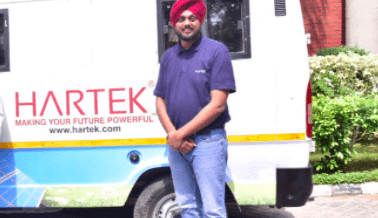Last Updated on December 16, 2020 at 9:37 am
Chandigarh-based company Hartek Solar Private Limited’s customised ‘plug-and-play’ residential rooftop solar kits are very significant in the evolution of the energy sector.
These solar kits are installed in 500+ residences across Punjab, Chandigarh, Madhya Pradesh, Haryana, Gujarat and Andhra Pradesh over the past two years. These customised rooftop solar kits enable their consumers to generate their own sustainable, clean and affordable power and decrease their dependence on electricity.

These solar kits hardly have any maintenance cost. Customers have option to monitor the energy produced by these rooftop solar kits using remote sensing technology supported by an in-house app. The company claims that it has connected more than 1,500 MW of solar projects to the grid and completed rooftop solar projects of 25 MW.
Entrepreneur Simarpreet Singh started working on the project from 2015. Hartek Solar Pvt Ltd started its business operations in FY 2017-18. It belongs to a larger power conglomerate Hartek Group. Simarpreet’s father Hartek Singh is a first-generation entrepreneur who set his steps into the power sector in 1991. Simarpreet was also included in the Forbes ’30 under 30′ Asia list last year for his contribution in solar energy.
Former President Dr APJ Abdul Kalam’s speech in 2011 inspired Simarpreet to foray into the solar energy sector. At that time, he was pursuing his Bachelors of Technology in electrical engineering from a private college in Punjab. His basic idea before starting Hartek Solar was that every consumer should be free from the electricity grid, and generate their own electricity. Their fate should not be decided by a large electricity generating and distributing corporation.
Hartek had a brief period of trial and error. However, after a while Hartek Solar decided a model for residential segment similar to the Swedish multinational furniture company IKEA, which gives their consumers freedom to choose their own furniture. He says that at that time, solar companies were installing standard rooftop solar energy installations in all the houses irrespective of their specific requirements. These installations would generate the same amount of power – usually 10 kilowatts peak (kWp).
Simarpreet says that in their case, an engineer would come to customers’ home and they would customize the rooftop solar power installation based on their needs. For example, if someone has a budget of installing 2 or 3 kWp, they will design it accordingly. They wouldn’t push for installing a standard 10 kWp setup. He argues that every rooftop is different and their power requirements are different so, every customer should have customized installations.
Another key feature of their company is the remote sensing technology which monitors the generation and savings of solar energy. This data is sent either to the consumer’s SIM card or WiFi connection. Customers have to install their app and log in to receive the data. This app help them check the amount of solar energy generated, saved and if maintenance is required.


